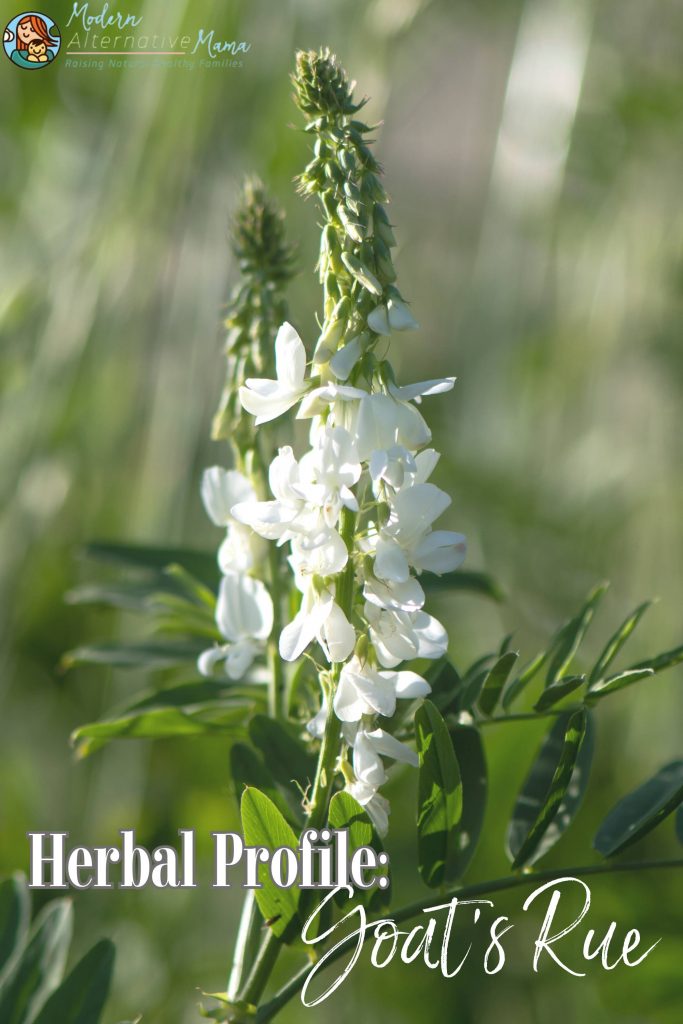What is Goat’s Rue
Goat’s rue, often called galega, French lilac, Italian fitch, or its scientific name Galega officinalis, is a part of the Fabaceae (pea) family (1). Goat’s rue is an aggressively invasive perennial toxic to animals but not humans. Goat’s rue, not to be mixed up with rue (Ruta graveolens), can be identified by its purple, blue, or white flowers that grow on its pea-like stalk. Each flower produces one seedpod, which contains nine bean-shaped seeds upon blossoming. Another identifying feature of goat’s rue is its compound leaves, containing 6 to 10 pairs of leaves on each side and a single leaflet at the tip (2).
Health Benefits of Goat’s Rue
In the pharmaceutical industry, goat’s rue is known for its anti-diabetic properties, which were synthesized to create the commonly prescribed drug Metformin. In the herbal world, goat’s rue is respected for its many medicinal benefits, such as:
Antioxidant Properties
Antioxidants can help fight damage from harmful free radicals. The buildup of free radicals has been linked to chronic diseases, such as cancer and heart disease (3). In animal studies, goat’s rue extract neutralized reactive oxygen species (ROS) and bound to metal ions, demonstrating antioxidant activity greater than yacon extract (4). Another study proved that compounds in goat’s rue exhibit antioxidant activity and can trap methylglyoxal (5).
Anti-Inflammatory Properties
Aside from the already discussed antioxidant properties, goat’s rue has anti-inflammatory properties. Although inflammation is a natural bodily response, chronic inflammation can lead to detrimental health effects. Chronic inflammation has been linked with many diseases, such as type 2 diabetes, asthma, and certain cancers (6). Thankfully, goat’s rue may help inflammation.
Most studies highlighting the anti-inflammatory benefits of goat’s rue look at the pharmaceutical industry’s synthesized variation, Metformin (7,8,9). Aside from the many studies focusing on Metformin, the study that demonstrated antioxidant activity greater than yacon extract also found active components of goat’s rue suppress pancreatic inflammation (4). Another study showcased that components in goat’s rue, like flavonoids, phytol, squalene, campesterol, and stigmasterol, possess anti-inflammatory properties (10).
May Promote Heart Health
Unfortunately, heart disease is the world’s number one cause of death (11). Due to the incredibly complex determinants of heart disease and various possible contributions, it’s hard to pinpoint an exact way to prevent it. Still, you can at least take steps to lower your overall risk. That’s where goat’s rue may come in.
Most information regarding heart health focuses on Metformin, which has beneficial effects on heart and cardiovascular disorders (7). One animal study showcased the antihypertensive effect of galegin (a compound of goat’s rue) in rats (12). Further research exhibits the hypocholesterolemic properties of goat’s rue (13).
May Help Control Diabetes & Blood Sugar Levels
As of 2020, 34.2 million (1 in 10) Americans have diabetes, and another 88 million (1 in 3) Americans have prediabetes (14). On the bright side, goat’s rue has amazing diabetic benefits, which led to the synthesizing of galegin to create Metformin (15). One study confirmed the presence of manganese, copper, and selenium in goat’s rue extracts, further enhancing the herb’s natural anti-diabetic effect (16). In animal studies, goat’s rue extract had a prolonged hypoglycemic effect even after discontinuing treatment (17).
May Promote Liver Health
The liver is the largest internal organ, responsible for over 500 vital functions like bile production, detoxification, production and regulation of vital bodily processes, and more (18). Again, liver health studies predominantly look at the synthesized galegine in Metformin. In animal studies, Metformin reversed fatty liver disease in obese, leptin-deficient mice (19). In human studies, Metformin significantly reduced liver enzyme levels in patients with non-alcoholic steatohepatitis (NASH), a variation of nonalcoholic fatty liver disease (20,21).
May Increase Breastmilk Supply
Lactation occurs when hormonal changes signal the mammary glands to make milk in preparation for a baby (22). Aside from goat’s rue’s well-known anti-diabetic effects, it’s also used internationally as a galactagogue (23,24). One study found goat’s rue beneficial for enhancing milk supply while breastfeeding and having positive psychological effects during the postpartum period (25).
May Aid In Weight Loss
Weight management is a challenge for most people in the U.S., with more than 70% of American adults being overweight (26). Excess body weight is a common contributor to type 2 diabetes, the most common type of diabetes. Being overweight increases your risk for type 2 diabetes, heart disease, and stroke (27). Although there aren’t many studies, weight-reducing properties have been recognized in goat’s rue (28). In animal studies, goat’s rue was one of four ingredients in a powder that demonstrated 10% weight loss in mice after 28 days of use (29).
Anticancer Properties
Statistics say that 158.3 of every 100,000 individuals will die from cancer, but what if they didn’t have to (30)? Thankfully, several studies indicate cancer-fighting properties in goat’s rue. Of course, research starts with Metformin because they need to push their pharmaceuticals.
Metformin displays significant growth inhibitory effects on breast, colon, endometrial, ovarian, prostate, and cancer cells (31,32,33,34,35). One study even found Metformin blocked the cell cycle progression of the C6 rat glioma (brain tumor) cell line without inducing significant cell death (36,37). Metformin aside, one study concluded that goat’s rue extract may possess anticancer effects against lung adenocarcinoma and brain glioblastoma (38).
Safety Concerns
According to mainstream sources like WebMD, there isn’t enough reliable information to know if goat’s rue is safe or what the side effects may be. For this reason, they caution against goat’s rue during pregnancy and while breastfeeding. Additionally, they state that although no harmful effects have been reported in humans, fatal poisonings have occurred in grazing animals after large quantities of goat’s rue consumption (39).
Although trusted herbalist Richard Whelan has no information on goat’s rue, Mountain Rose Herbs says there are no known precautions (40). Although the mainstream claims there isn’t enough reliable information on the safety profile of goat’s rue, I’ve compiled plenty of evidence throughout this herbal profile to articulate its safety.
How to Use Goat’s Rue
You can find goat’s rue in dried bulk, pills, powders, teas, extracts, or tinctures. Tinctures usually contain the most concentrated amount of herbs. Teas and soups are also options, especially when following Ayurvedic medicine recipes. If you’re a DIY person, some great starter recipes are:
- How to Make an Alcohol Extraction (With Almost Any Herb) – to make a goat’s rue tincture
- How to Make a Glycerin Extraction (With Almost Any Herb) – to make an alcohol-free goat’s rue tincture
Disclaimer: This post is not intended as medical advice. These statements have not been evaluated by the FDA, and nothing in this post is intended to diagnose, treat, or cure anything. If you have questions, please do your own research or seek advice from a health professional.







